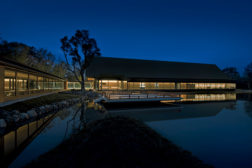Naomi Pollock, FAIA
Contributing Editor Naomi Pollock, FAIA, is the author of Japanese Design Since 1945: A Complete Sourcebook and the editor of NUNO: Visionary Japanese Textiles.
ARTICLES
Finding inspiration in quirky, leftover urban sites, an architect makes the job of fitting in a defiant act of design.
Read More
Louis Vuitton Matsuya Ginza Facade
Architect Jun Aoki's new facade for Louis Vuitton in Tokyo's Ginza district is a glowing tour de force that sets the shop apart from the Matsuya Department Store that houses it.
Read More
Nishinoyama House
Working All the Angles: Kazuyo Sejima designs 10 apartments united by a sequence of overlapping roof planes in Kyoto.
Read More
Ando Museum
Modern to the Core: Challenged to create a building in which to showcase his own work, a celebrated Japanese architect constructs a series of unique spaces within the shell of a historic house.
Read More
Copyright ©2024. All Rights Reserved BNP Media.
Design, CMS, Hosting & Web Development :: ePublishing
